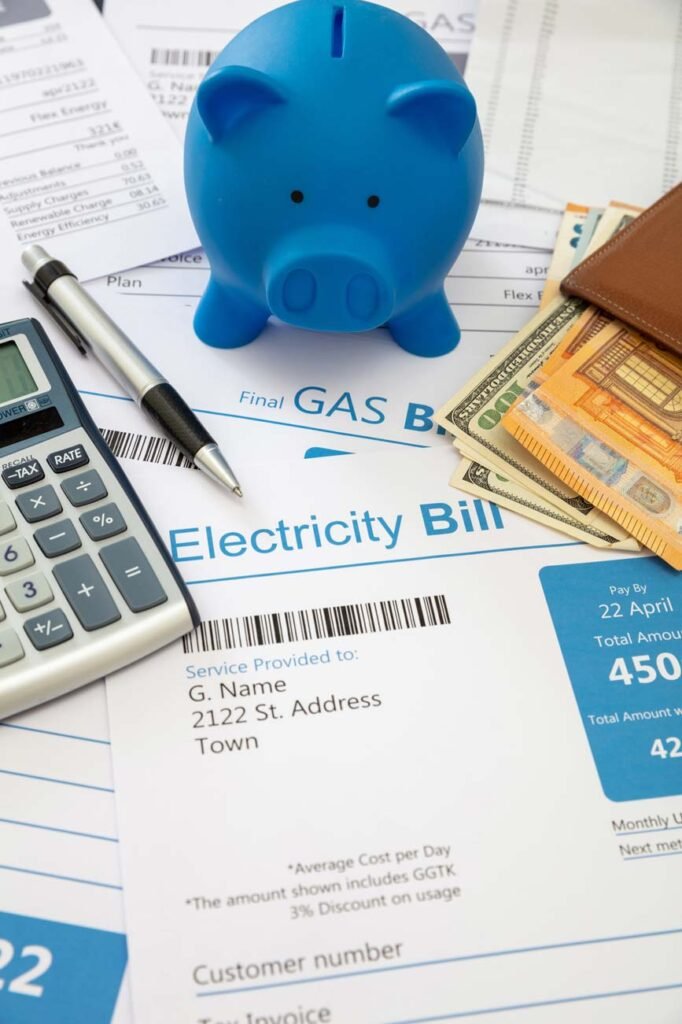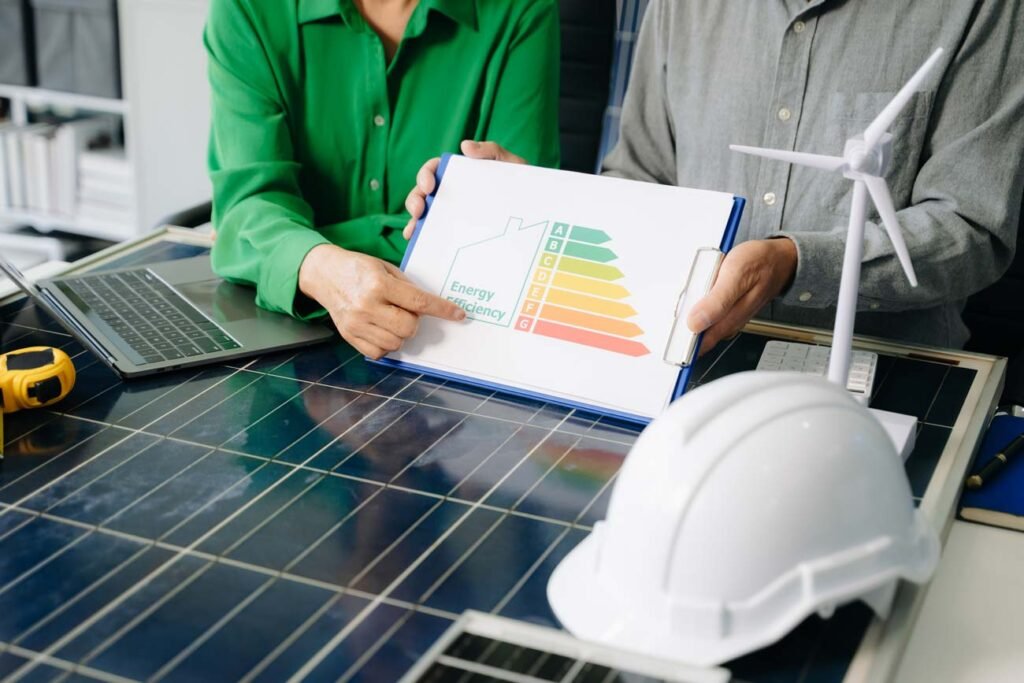Choose your path and get a fast SME energy quote or a domestic energy switching quote in minutes. Upload a recent bill, compare energy rates, and let us handle the switch—no supply interruption, no hidden fees, full commission disclosure.

A UK business energy bill consists of several key components that determine total costs. The unit rate multiplied by consumption in kWh forms the largest charge, whilst standing charges represent fixed daily fees for network connection. VAT typically applies at 20%, though some businesses qualify for a reduced 5% rate.
The Climate Change Levy adds an environmental tax at 0.775p per kWh with sector-specific exemptions. MPAN and MPRN numbers identify electricity and gas supply points respectively. Regular bill reviews help identify common errors like estimated readings and misapplied tariffs. Comprehending these elements enables businesses to verify accuracy and control energy expenses more effectively.
The unit rate forms the foundation of every business energy bill, representing the price charged per kilowatt-hour (kWh) of electricity or gas consumed during the billing period. This charge typically constitutes the largest component on energy bills, calculated by multiplying total consumption by the tariff’s unit rate expressed in pence per kWh.
The unit rate—charged per kilowatt-hour consumed—forms the largest component of business energy bills and determines overall usage costs.
For example, 100 kWh consumed at 20p per kWh equals £20 in usage charges.
Unit rates comprise multiple cost elements: wholesale electricity purchases from generators, Transmission Network Use of System charges, Balancing Services costs, Contracts for Difference levies, and Renewable Obligation Certificate expenses. The unit rate also includes costs for renewable energy subsidies that support the development of clean energy infrastructure.
Fixed tariffs maintain consistent rates throughout the contract term, whilst variable tariffs fluctuate with market conditions. Multi-rate metres apply different unit rates for peak and off-peak consumption periods. Structuring consumption data in standardised formats enables businesses to make fair comparisons between suppliers and identify genuine cost-saving opportunities. Professional usage profiling can help identify consumption risks and establish accurate comparison baselines when evaluating different energy contracts.
Beyond consumption-based charges, business energy bills include standing charges—fixed daily fees that apply regardless of whether any electricity or gas is actually used. These charges maintain connections between business properties and national energy networks, calculated per metre and added cumulatively to monthly bills.
Standing charges vary considerably by business size and supplier:
| Business Size | Daily Electricity Standing Charge | Annual Impact (% of Bill) |
|---|---|---|
| Micro | 40.5p | 16.65% |
| Small | Variable | 6.73% |
| Medium | 83.1p | 5.45% |
| Large | 214.1p | Lower percentage |
The charge comprises three main components: operating costs (45%), network costs (36%), and policy costs including green levies (7.4%). Factors influencing calculations include TCR bands, supplier choice, contract type, and regional distribution network costs.
Businesses with multiple metres across their premises will incur multiple standing charges, as these fixed fees apply separately to each metre point. Some suppliers offer no standing charge tariffs as an alternative, though these typically come with higher unit rates that may not benefit all businesses.

Most business energy bills include VAT at the standard rate of 20%, which applies to both electricity and gas consumption.
However, certain businesses qualify for a reduced VAT rate of 5% based on specific criteria such as low energy usage, charitable status, or particular organisational types. This de minimis rate applies to businesses using less energy, helping to reduce overall costs for eligible organisations.
Comprehending these VAT rates and eligibility requirements enables businesses to identify potential savings and determine whether they should apply for the reduced rate through their energy supplier.
Business energy bills in the UK carry a standard VAT rate of 20%, which has remained unchanged since 2011 when it increased from the previous 17.5% rate.
Energy providers automatically apply this rate to business electricity and gas bills without requiring intervention from the business itself. This represents a significant cost difference compared to domestic customers, who benefit from a reduced 5% VAT rate on their energy consumption.
The financial impact proves substantial across all business sizes. For example, a £100 monthly energy usage becomes £120 after VAT addition.
Annual costs vary considerably depending on consumption levels, with microbusinesses paying £534 in VAT compared to large businesses paying £2,709 annually at the standard rate on their energy bills.
However, businesses using limited energy may qualify for a discounted rate of 5% if their electricity consumption falls below 33 kWh per day, 1,000 kWh per month, or 12,000 kWh per year.
While the standard 20% VAT rate applies to most business energy consumption, specific circumstances allow certain organisations to qualify for the reduced 5% rate typically reserved for domestic customers.
Businesses consuming minimal energy automatically receive the discount when electricity usage stays below 33 kWh daily, 1,000 kWh monthly, or 12,000 kWh annually.
Gas thresholds stand at 145 kWh daily, 4,397 kWh monthly, or 52,764 kWh yearly.
Registered charities qualify when energy supplies buildings used for charitable activities, though mixed-use premises require proportional calculations.
Care homes, student accommodation, hospices, and children’s homes receive reduced rates when at least 60% of consumption serves residential purposes.
Mixed-use properties combining business and domestic usage need detailed consumption breakdowns.
Businesses must submit VAT declaration forms to suppliers before reduced rates apply.
Suppliers should automatically apply the 5% VAT discount if a valid VAT certificate is provided.
Since 2001, the Climate Change Levy has functioned as a government tax on electricity, gas, and other fuels used by non-domestic consumers in the UK.
The tax incentivises energy efficiency and decarbonisation by imposing charges on business energy consumption. The main CCL rate stands at 0.775p per kWh for both natural gas and electricity, increasing to 0.801p per kWh from 1 April 2026.
Several exemptions exist: domestic users pay no CCL, whilst charities, small consumers (under 145 kWh daily gas or 33 kWh daily electricity), and community heating schemes qualify for full relief.
Specialised exemptions include Climate Change Agreement participants, Energy Intensive Industries with qualifying NACE codes, and certain transport operations. The financial relief from these exemptions supports job creation and enables reinvestment in innovation and employee development within energy-intensive sectors.
Businesses can backdate CCL exemption claims up to four years if previously charged incorrectly.

Every business energy bill contains critical reference numbers that identify the specific supply point: the MPAN (Meter Point Administration Number) for electricity and the MPRN (Meter Point Reference Number) for gas.
The MPAN, often labelled “Supply Number” or “S Number,” consists of 21 digits arranged in two rows (8 digits, then 13 digits). It typically appears under “Details of Charge” or in clearly marked boxes at the top left or bottom right of electricity bills. If the MPAN is not visible on your bill, you can obtain it by contacting your current supplier directly.
The MPRN identifies gas metres and uses an “M” designation. Both numbers remain constant when switching suppliers, as they identify the property’s supply point rather than customer accounts.
Most suppliers require only the last 13 MPAN digits for switches or contract management. These numbers prove essential for supplier switches, contract administration, and resolving billing disputes.
Beyond the basic unit rates and standing charges, business energy bills contain numerous additional components that can substantially increase total costs if not properly understood. VAT typically applies at 20%, though certain businesses qualify for a reduced 5% rate. The Climate Change Levy (CCL) functions as an environmental tax, with exemptions available for specific sectors.
| Charge Type | Description |
|---|---|
| Network Charges (TNUoS, DUoS, BSUoS) | Demand-based fees for national grid usage, local distribution networks, and real-time system balancing |
| Renewable Levies (CfD, ROC) | Contracts for Difference levy and Renewable Obligation Certificates subsidising renewable energy development |
| Hidden Broker Costs | Padded unit rates and undisclosed commissions buried in fine print |
Common billing errors include estimated readings causing inaccuracies and incorrect meter category setups resulting in wrong tariff applications and overcharging.
